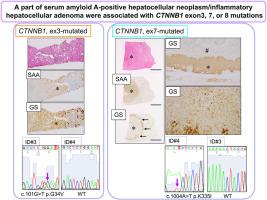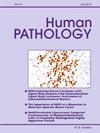血清淀粉样蛋白a阳性肝细胞瘤/炎症性肝细胞腺瘤中CTNNB1突变
IF 2.6
2区 医学
Q2 PATHOLOGY
引用次数: 0
摘要
背景:血清淀粉样蛋白a阳性肝细胞肿瘤(SAA-HN)发生于酒精性肝硬化,现在被认为是一种特殊类型的炎症性肝细胞腺瘤(IHCA),与晚期肝病相关。由于最近的研究报道了β-catenin突变的HCA中与CTNNB1突变相对应的各种谷氨酰胺合成酶(GS)表达模式,因此本文重新评估了SAA-HN/IHCAs中CTNNB1突变的情况。方法:从我们的文献中检测了33例SAA-HN/IHCAs(23例)和15例IHCAs(14例)的GS表达,并将其分为模式(P) 1-3 (P1,弥漫性均匀模式,提示外显子3-非s45突变;P2,弥漫性异质模式,提示外显子3-S45突变;P3、边缘和局灶异质,提示外显子7/8突变)和P4(阴性)。结果:33例SAA-HN/IHCAs分为3个P1、1个P3和29个P4, 15例HCAs分为3个P1、1个P2、2个P3和9个P4。遗传分析显示,3个SAA-HN/IHCAs分别具有CTNNB1外显子3突变和1个外显子7突变,与GS表达模式P1和P3一致。两种SAA-HN/IHCAs与CTNNB1外显子8突变相关,基于GS表达模式均视为P4。CTNNB1突变的SAA-HN/IHCAs的临床病理特征与未发生CTNNB1突变的SAA-HN/IHCAs无显著差异(p < 0.05)。结论:一些SAA-HN/IHCAs可能是b-IHCA,外显子3或外显子7/8突变。仔细评估GS的免疫反应性和CTNNB1突变的遗传分析对于准确诊断b-IHCA外显子3突变(恶性转化风险高)和更好的临床管理至关重要。本文章由计算机程序翻译,如有差异,请以英文原文为准。

CTNNB1 mutations in serum amyloid A-positive hepatocellular neoplasm/inflammatory hepatocellular adenoma arising in alcoholic cirrhosis
Background
Serum amyloid A-positive hepatocellular neoplasm (SAA-HN) arising in alcoholic cirrhosis is now regarded as a specific type of inflammatory hepatocellular adenoma (IHCA) associated with advanced liver disease. Since recent studies reported various glutamine synthetase (GS) expression patterns corresponding to CTNNB1 mutations in β-catenin mutated HCA, SAA-HN/IHCAs were herein re-evaluated for CTNNB1 mutations.
Methods
GS expression was examined in 33 SAA-HN/IHCAs (23 patients) and 15 IHCAs (14 patients) from our archives and classified into patterns (P) 1–3 (P1, a diffuse homogeneous pattern suggesting an exon 3-non-S45 mutation; P2, diffuse heterogeneous, suggesting an exon 3-S45 mutation; P3, rim and focal heterogeneous, suggesting exon-7/8 mutations) and P4 (negative). Hotspot genetic mutations in CTNNB1, exons-3, 7, and 8 were examined by direct sequencing.
Results
Thirty-three SAA-HN/IHCAs were classified into 3 P1, one P3, and 29 P4 and 15 HCAs into 3 P1, 1 P2, 2 P3, and 9 P4. A genetic analysis revealed 3 SAA-HN/IHCAs with CTNNB1, exon-3 mutations and 1 exon-7 mutation, consistent with GS expression patterns P1 and P3, respectively. Two SAA-HN/IHCAs were associated with CTNNB1, exon-8 mutation, and both were regarded as P4 based on GS expression patterns. No significant differences were observed in clinicopathological features between SAA-HN/IHCAs with and without CTNNB1 mutations (p > 0.05).
Conclusions
Some SAA-HN/IHCAs may be b-IHCA, exon-3 or exon-7/8 mutations. Careful evaluation of immunoreactivity for GS and a genetic analysis of CTNNB1 mutations are crucial for the accurate diagnosis of b-IHCA, exon-3 mutation, for which the risk of malignant transformation is high, and better clinical management.
求助全文
通过发布文献求助,成功后即可免费获取论文全文。
去求助
来源期刊

Human pathology
医学-病理学
CiteScore
5.30
自引率
6.10%
发文量
206
审稿时长
21 days
期刊介绍:
Human Pathology is designed to bring information of clinicopathologic significance to human disease to the laboratory and clinical physician. It presents information drawn from morphologic and clinical laboratory studies with direct relevance to the understanding of human diseases. Papers published concern morphologic and clinicopathologic observations, reviews of diseases, analyses of problems in pathology, significant collections of case material and advances in concepts or techniques of value in the analysis and diagnosis of disease. Theoretical and experimental pathology and molecular biology pertinent to human disease are included. This critical journal is well illustrated with exceptional reproductions of photomicrographs and microscopic anatomy.
 求助内容:
求助内容: 应助结果提醒方式:
应助结果提醒方式:


